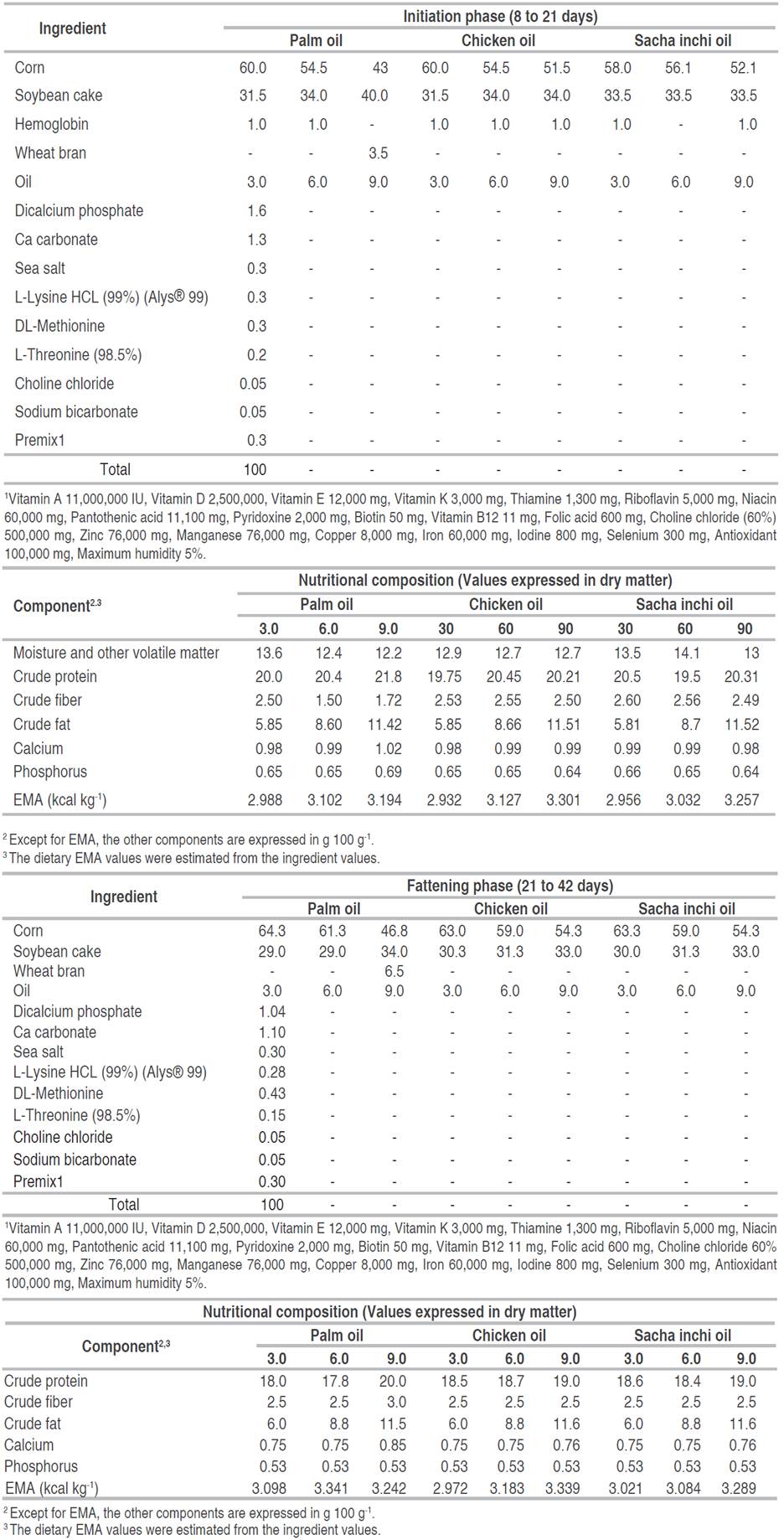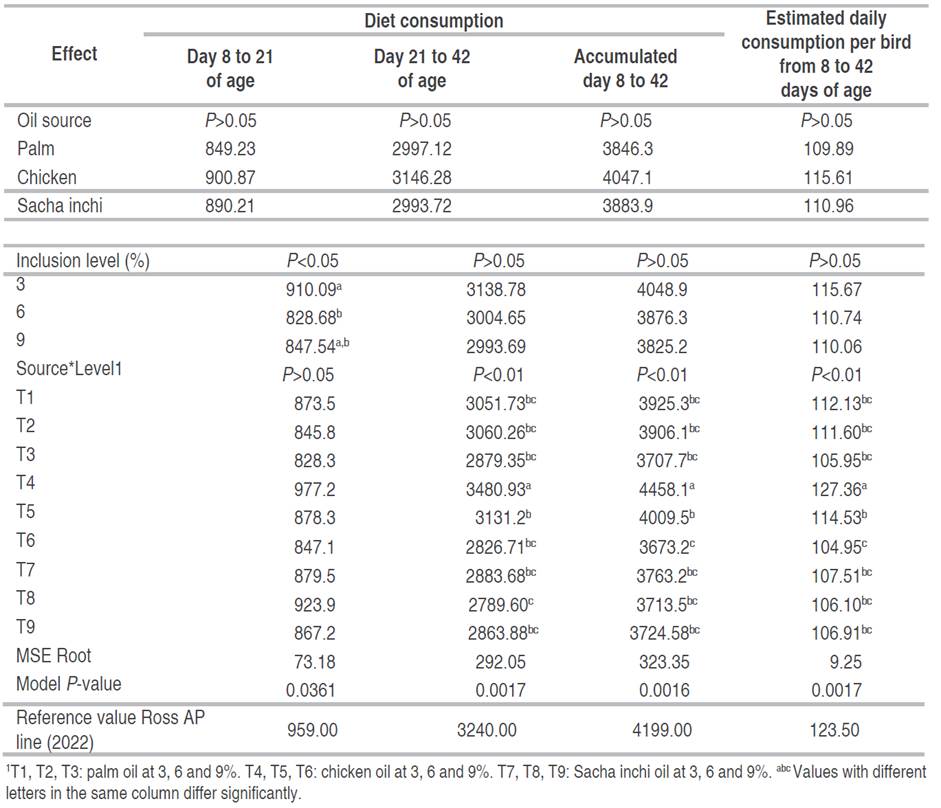Chicken devoted to meat production has changed in the last decades at all levels. This situation involved the change of their diets' structural design, which involves, among other aspects, the inclusion of ingredients with a high concentration of digestible or available nutrients and metabolizable energy. In specialized poultry production systems, how has been guaranteed to meet the metabolizable or net energy requirements has been mainly with foods high in starch, especially cereal grains such as corn, and, partially, with oil or fat sources or the combination of both (Wiseman et al. 1986). There is no doubt that if the goals set for broiler production remain on the horizon and the decision to use cereal grains for other purposes such as alcohol production is sustained, the feeding strategy should be reviewed because to the extent that there are no of feeds with higher starch concentrations than the current ones, there will be a need to review the issue of the use oil and fats in chicken feed.
In the ninth revised edition of Nutrient Requirements of poultry, the NRC (1994) recorded as appropriate broiler starter and finisher diets based on corn, sorghum, or wheat-soybean whose fat contents were between 0 and 10%. This is perhaps the first record that provided information, although not as a requirement, on the maximum level of fat that would be appropriate in diets. This same version also identified for the first time the requirement of 1% linoleic acid for chickens up to the eighth week of life and 0.8% between weeks 8 and 18; in addition, to keeping the 1% indicated since 1971 for laying hens and broilers. After more than 45 years after these first records, it is not possible to identify, even as a recommendation, the maximum level of inclusion of fat in the chickens' diet.
The use of fats or oils in food has positive effects on broiler productivity: they improve diets acceptance and they also decrease consumption because they are sources of high energy concentration, they contribute to the homogenization of diets, reduce losses due to the selection of particles, it lowers the rate of passage of digesta through the gastrointestinal tract and improve absorption of dietary nutrients, contribute with their performance rates improvement and minimize production costs (Ayed and Attia 2015; Pesti et al. 2002). The type of fat and oil added to diets has a direct effect on the level of abdominal fat deposited and on its lipid composition (Ayed and Attia 2015). Therefore, in broilers, the type of fat used in food affects the composition of their body lipids (Scaife et al. 1994).
Fast-growing modern broiler lines also have higher levels of body fat, becoming a problem for the poultry industry. Choct (2000) reported that these lines contain between 15 to 20% fat, where about 85% is not physiologically required for body functions, leading to excess fat deposition, carcass productivity reduction, and a negative effect on consumer acceptance.
The issue of fat addition to broiler's diets is complex. Since it is not part of the fractions and nutrients that record requirements, it falls in the recommendations field and they can be based on criteria set by the animal feed industry, the meat processing industry, the consumers, and finally by the nutritionists. Moreover, the tendency has been to design diets with fat levels not higher than 3%, with limited possibilities of attempting to expand them. This study aimed to evaluate three types of oil: palm oil, in which saturated fatty acids (SFA) predominate, chicken oil, highlighted by the highest proportion of monounsaturated fatty acids (MUFA), and Sacha inchi oil, in which polyunsaturated fatty acids (PUFA) stand out, with three levels of inclusion (3, 6 and 9%) in the broiler chickens' diet between their birth and their 42 days of age. The evaluation was based on their performance rates, such as body weight, feed intake, and feed conversion, and allometric characteristics such as carcass weight, breast, leg, skin, gizzard, liver, heart, and abdominal fat both in absolute and relative values.
MATERIALS AND METHODS
The study was carried out at San Pablo Agricultural Station of the Universidad Nacional de Colombia, Medellin Headquarters, located in the municipality of Rionegro, (Antioquia, Colombia), at 2,100 meters above sea level (masl), coordinates 6°07'51.3" N and 75°27'19.1" W. According to the living zone classification system, the station is listed: as a very moisture-low montane forest living zone (bmh-MB) (Holdridge 1978), characterized by a temperature range between 12 and 18 °C and an annual rainfall of 2,280 mm. At night and early hours of the day, the relative humidity reaches approximately 75.5%.
A total of 324 female Ross 308 line from a commercial incubator were used. The birds were received at 1 day of age and were housed during the first 8 days in an experimental hatchery of 126 m2, which was built with an east-west orientation, with natural ventilation, heating, and curtain management to guarantee a temperature of 30 °C, with a floor of cement and open water and commercial feed supply. When the birds were eight days old, they were moved to another hatchery with horizontal batteries of 0.7 m length x 0.75 m width x 0.6 m height. In the hatchery, heating and ventilation were maintained with gas brooders and managed with curtains.
Diets
During the first week of life, the birds were offered a commercial diet. From day 8 of age to day 42, birds had voluntary access to the experimental diets according to the following pattern. Two evaluation phases were established. The first one, called initiation, was with birds aged between 8 and 21 days old. And the second one, fattening, was with birds aged between 22 and 42 days old. For both phases, the diets were in the form of flour and were designed following the requirements of Rostagno et al. (2017). Except for oils, the nutritional facts of the ingredients used in these diets were taken according to the information provided by the supplier. The apparent metabolizable energy values of the oils were estimated from a trial previously performed. In each phase, nine diets were provided to account for three oils (commercial palm, commercial chicken, Sacha inchi), and three inclusion levels (3, 6, and 9%) were offered at each stage. The centesimal and nutritional composition of the diets is shown in Table 1. The diets' chemical composition analyses were carried out in the chemical analysis and bromatological laboratory at Universidad Nacional de Colombia, which is registered as a quality control laboratory before the Colombian Agricultural Institute according to registration LB0000432021 (December 7, 2021).
Variables studied
Considering each phase, the variables studied were diet consumption, weight, and feed conversion, and for the overall period, the variables were weight and carcass yield, breast, leg, liver, heart, gizzard, wings, skin, and abdominal fat on the day of slaughter. For the calculation of diet consumption, the weekly average consumption was considered, bearing the number of dead birds during the evaluated period. For the weight variable, the birds were weighed upon arrival at the station and then every week until the end of the experiment. The live weight information was gathered from the weight of the birds of each repetition and averaged according to the number of live birds. The estimation of the feed conversion was based on the average consumption of the diet divided by the live weight during the evaluated period, without taking mortality into account. Only the live weight, consumption, and feed conversion statistical analysis are presented considering two periods: between day 21 and 42 of age and between day 8 and 42 of age.
The evaluation of carcass weight, breast, leg, liver, heart, gizzard, wings, skin, and abdominal fat was made from data obtained from a slaughtered bird by replicate (six per treatment) on day 43 of age. Slaughter was performed by the cervical dislocation method. For abdominal fat weight, all fat surrounding the gizzard, bursa of Fabricius, cloaca, and adjacent muscles were removed and weighed individually. The procedure for weighing liver, heart, gizzard, wings, and skin was the same.
For the carcass yield determination, the weight of the hot carcass without feathers, head, neck, legs, and white viscera was considered in contrast to the live weight at slaughter time. The breast and leg, liver, heart, gizzard, wings, skin weight, and abdominal fat, were also taken in contrast to the animal's live weight.
Experimental design
The experiment was planned in a 3x3 factorial arrangement with the three types of oil (palm, chicken, and Sacha inchi oil) and three inclusion levels (3, 6, and 9%) with six repetitions per treatment and six birds per replicate, having a total of 324 birds. The nine treatments were randomly distributed in the 54 cages.
Statistical analysis
Weekly weight analysis was using a linear regression model with weight at one week of age as the independent variable. Carcass variables were analyzed as absolute weight and as an average of each variable in relation to slaughter weight. Considering the absolute weight, a linear regression analysis was run in which slaughter weight was selected as the independent variable and carcass variables as the dependent ones. The bird's weight when slaughtered did not influence the abdominal fat, skin, or heart weight; therefore, the statistical analyses performed on these variables model included: this weight, the oil source effect, the level of inclusion, and the interaction between these two factors. In the analysis model for the other variables such as carcass, breast, legs, wings, gizzard, and liver weight, slaughter weight was not included. The variance analysis for each variable was performed using the General Linear Model. The average values of each treatment were compared using the SNK test. All statistical analyses were performed by means of the SAS Version 9 program.
The implemented model followed equation 1.
Where:
Yijkl: the expected response from the experimental unit, becomes the m-th observation in the response variable.
µ: experimental media.
Fi: the i-th oil source effect.
Nj: the j-th level of oil inclusion effect.
Tk: the k-th interaction (diet) effect.
Eijkl: residual error associated with the l-th experimental unit.
RESULTS AND DISCUSSION
No adverse effects on the chicks associated with the conducted conditions were observed during the experiment.
Dietary consumption
Table 2 shows the results of the diet consumption analysis during the following periods: from day 8 to day 21 of age, day 21 to day 42, the accumulated from day 8 to day 42, and the estimated daily average per bird. The comparison between the intakes recorded in the experiment versus the reference ones shows that besides some exceptions, the intakes in the experiment were below the performance objectives of the genetic line; highlighting the results regarding T4 (chicken oil at 3% inclusion), which were above those expected for the line. In the study, there was no consistent effect of the evaluated factors on consumption. For all evaluated periods, there was no oil source effect, nor the composition of its fatty acids, during the period from day 8 to day 21 of age; consumption declined with the increase in the inclusion level. In relation to the interactions between the source and the level of inclusion, it was possible to establish that the trends were similar during the period from day 21 to day 42 of age and between day 8 and day 42 of age: in both palm oil and Sacha inchi oil, the level of inclusion did not affect consumption; but regarding chicken oil, the highest consumption was achieved with 3% inclusion, with no difference between the two other levels.
Body weight
Table 3 shows the results of the analyses carried out for body weight between day 8 and 21 of age, day 21 to 42, until day 42, and accumulated daily gain per bird. The estimated weight gains for females of the genetic Ross AP line (2022) for the periods between day 8 and 21 of age, 22 to 42, up to day 42 and the daily gain for the whole period provide values of 784, 1,858, 2,856 g, and 66.95 g d-1. The comparison between these values with those of the study shows that there were higher values in the study when palm oil and chicken oil were used, in the three inclusion levels, and all interactions between oil source and inclusion level except for T2 and T3 (palm oil at 6 and 9%) for the period between day 8 and 21 of age and all situations for daily weight gain. In the study, the only treatment that showed higher values than those of the genetic line was T2 (6% palm oil) between days 21 and 42 of age.
Table 3 Effect of the oil source, inclusion level, and interaction between source and inclusion level on weight gain between days 8-21, 21-42, and day 42 of age and cumulative weight gain (Values expressed in grams).
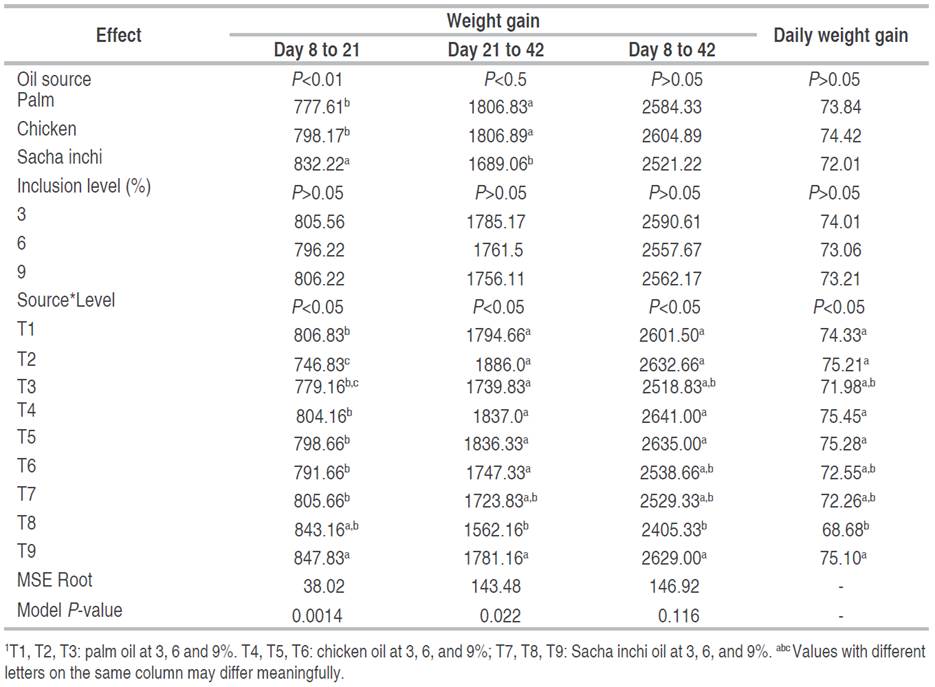
The oil source affected weight gain for the periods between days 8 to 21 of age and days 21 to 42 of age. During the first period, Sacha inchi oil promoted the highest weight, but there was no difference between the other two sources. For the period from day 21 to 42 of age, Sacha inchi oil made birds with lower weights, keeping no difference between the other sources. Between days 8 to 42 of age, daily weight gain throughout the experimental period was not affected by the oil source. Ferrini et al. (2008) evaluated the effect of the 10% inclusion of different sources of fats and oils (tallow, high oleic sunflower oil, high linoleic sunflower oil, high linolenic linseed oil, and a mixture of 55% tallow, 35% linseed oil, and 10% high linoleic sunflower oil) on weight gain between day 8 and 42 of age in Ross 308-line broilers. Even though the response among the different sources changed, it was possible to establish that the lowest gains were obtained from the sunflower oil and flaxseed oil diets, while the highest gains were obtained with the mixture, having no difference from the tallow diet.
Regarding the level of inclusion of the oil sources evaluated, it has been established that there was no effect on this variable in all the periods evaluated; however, an effect on the interaction between the oil source and the level of inclusion was found. It was not possible to identify any type of trend in the effect of the interaction in the periods evaluated, suggesting that the birds' behavior had been independent with respect to the diet. Considering the above, the analysis will be focused on the period from day 8 to 42 of age and the daily weight gain of the entire experimental period. According to the results, the behavior in the three levels of inclusion of palm and chicken oils was similar, but there was a difference in the Sacha oil between 6 and 9%. If the analysis is performed by the level of inclusion at 3%, there is no difference between the three sources; at 6 and 9%, Sacha oil brought a difference in weight. Crespo and Esteve-Garcia (2001) in Ross 308 females evaluated comparing the one carried out in this study, a basal diet without added fat, and four diets with the addition of 10% of tallow (saturated fatty acids), olive oil (monounsaturated fatty acids), sunflower oil and flaxseed oil (polyunsaturated fatty acids) in a shorter period (between day 28 and 42 of age) than in this study. The results from the statistical analysis showed that the diets with the addition of different oils produced birds that weighed an average of 144 g more than those fed with the basal diet, but there was no difference between the diets with 10% fat added.
Dietary conversion
Table 4 shows the results of the analyses carried out for the diet conversion variable. The specific result of this study shows that the oil source did not affect the conversion variable, and there was only an effect of the oil inclusion level for the period between day 8 and 21 of age, and the interactions between the oil source and the inclusion level were only significant during the period between day 21 and 42 of age, including the overall period (between day 8 and 42 of age). According to the above, it was noted that the best feed conversion rate was obtained with the highest level of inclusion, without being different between the two previous levels of inclusion. As with the weight gain variable, it cannot be possible to identify any type of trend in the periods evaluated from the effect of the interaction, suggesting again that in each period there was independence in the behavior of the birds regarding the diet. For the fattening phase, from day 21 to 42 of age, there was no difference among the three levels of inclusion on the palm oil and Sacha inchi oil, but in chicken, oil the worst conversion was at 3% inclusion; in fact, the most limited conversions were obtained with T1 (3% palm oil), T4 (3% chicken oil) and T8 (6% Sacha oil), with no differences among them. At 6 and 9% there was no difference among the three oil sources. For the entire experimental period in palm and Sacha oil, there was no difference among the three inclusion levels, but for chicken oil the worst conversion was at 3% inclusion, at this level, there was no difference between palm and Sacha oils. Based on these results, it could be agreed that to improve the feed conversion rate, the use of oils with saturated and monounsaturated acids, such as palm and chicken oils, would require higher inclusion levels. Different story for polyunsaturated lipid sources such as Sacha inchi, since the conversion would be better at the inclusion level. Griffiths et al. (1977) reached different conclusions. These researchers conducted two experiments in male broilers to evaluate whether the fat sources (two mixtures of animal and vegetable fat, corn oil, and chicken oil) and the level of inclusion (at 0, 3, 6, and 9%) had an extra caloric effect and whether the system of expression of dietary energy - metabolizable or net - influenced the animal response or not. At eight weeks of age, birds fed with formulated diets based on the net energy system had carcasses with less fat and more protein.
Table 4 Effect of oil source, inclusion level, and interaction between source and inclusion level on diet conversion between days 8-21, 21-42 of age, and cumulative between days 8 and 42 of age.
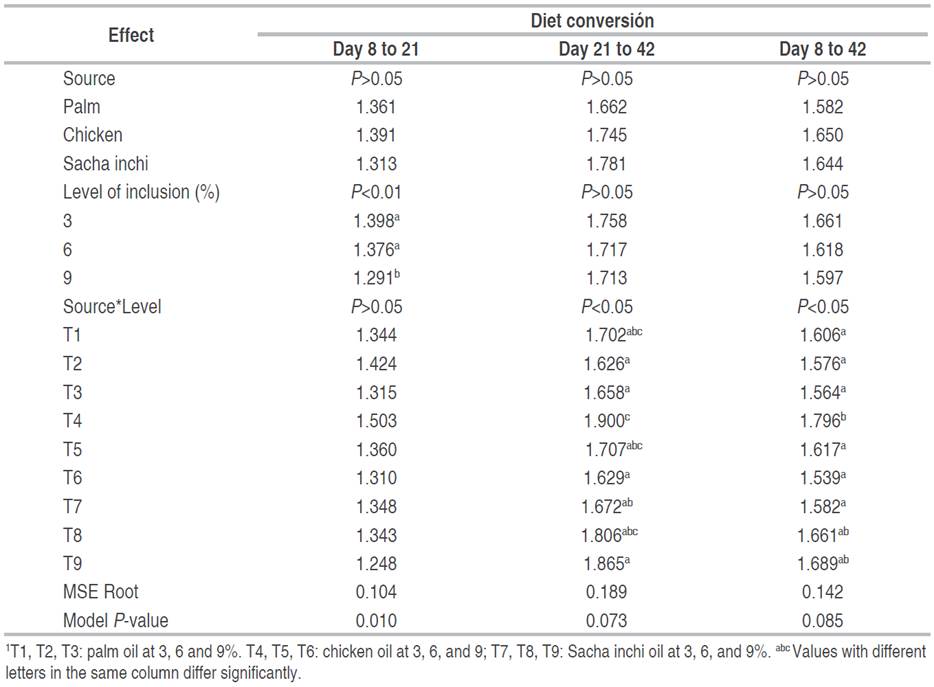
The inclusion of corn or chicken oil, with no mixtures of animal fat and vegetable oil, produced heavier birds, without including the level of oil inclusion in the diet. In research conducted by Gaiotto et al. (2000) where soybean oil, acid soybean oil, and bovine tallow with 4% inclusion were used in broiler diets, no difference was established in consumption, weight gain, and feed conversion for the initiation stage neither for the complete cycle from day 1 to 42 of age, as well as no effect on the relative weight of abdominal fat. Several authors have evaluated the effect of oil sources or their inclusion level on the performance of poultry at different stages. For example, Pinchasov and Nir (1992) planned an experiment in which they combined different amounts of vegetable oils and tallow that created varied concentrations of polyunsaturated fatty acids (32, 48, 60, 63, and 70 g 100 g-1 of fat). From the performance variables evaluated (body weight at day 21 and 40 of age, weight gain between day 21 and 40 of age, feed intake, and the ratio of weight gain to diet intake), the reference between weight gain to diet intake was the only one affected linearly with the increase in the concentration of polyunsaturated fatty acids in the diet. Scaife et al. (1994) conducted a study to evaluate the effect of the inclusion of 5% of fats with different chain lengths and degrees of unsaturation (bovine tallow, soybean oil, rapeseed oil, oil of marine origin, and a mixture of 0.5:0.5 wt/wt of these fats) upon the performance (diet intake, live weight and featherless weight), carcass characteristics, lipid concentration and fatty acid composition of abdominal fat, liver and breast of male broilers between day 19 and 54 of age. Regarding the performance variables, the birds that received the diet with beef tallow consumed more and presented higher body weights and featherless weights, while with canola oil these indicators were lower. Of all diets, the one that produced the most limited feed conversion was the one with beef tallow. Several researchers found no difference in dietary intake, weight gain, and feed conversion in birds fed with different fat sources and their mixtures (Duarte et al. 2010). Works submitted by Gaiotto and his contributors in 2000, where they used different sources of oils and fats in broilers reported no difference in diet consumption between the sources used, nor for weight gain or feed conversion during the phase from day 1 to 42 of age. The comparison between a control diet with no added fat and other diets with 3% soybean or palm oil (Ayed and Attia 2015) found no difference in feed intake in the starter phase between a control diet with no added fat and other diets with the addition of 3% soybean and palm oil.
Carcass and organ variables
Tables 5 and 6 show the results of the analyses carried out on the variables associated with the carcass and some of the organs evaluated, understood as absolute weight or as the rated weight for slaughter.
Table 5 Effect of oil source, inclusion level, and interaction between source and inclusion level on the weight of some carcass and organ components of broiler chickens (Values expressed in grams).
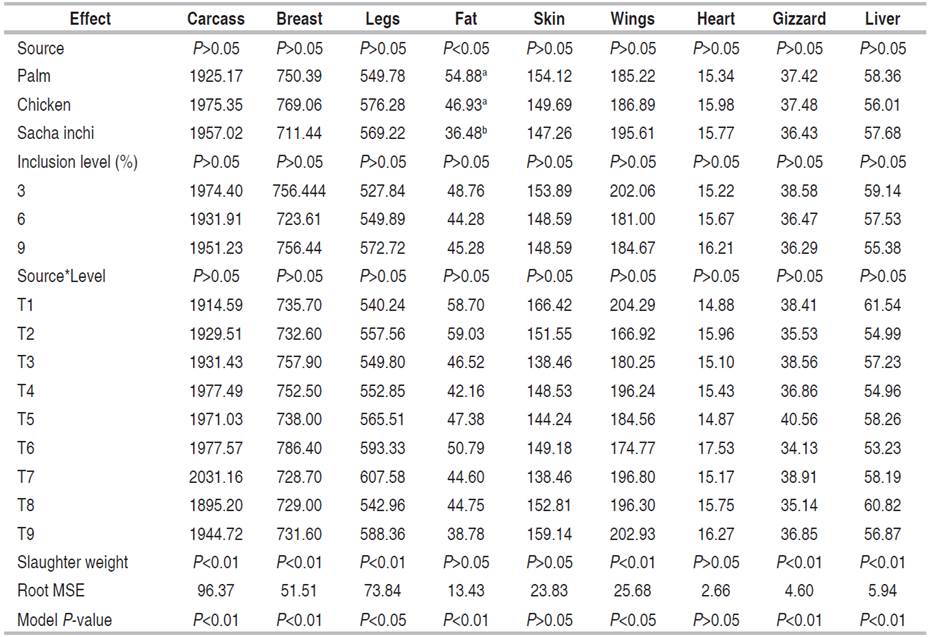
Table 6 Effect of oil source, inclusion level, and interaction between source and inclusion level on the weight of some carcass and organ components of broiler chickens (Values expressed as percentage of slaughter weight).
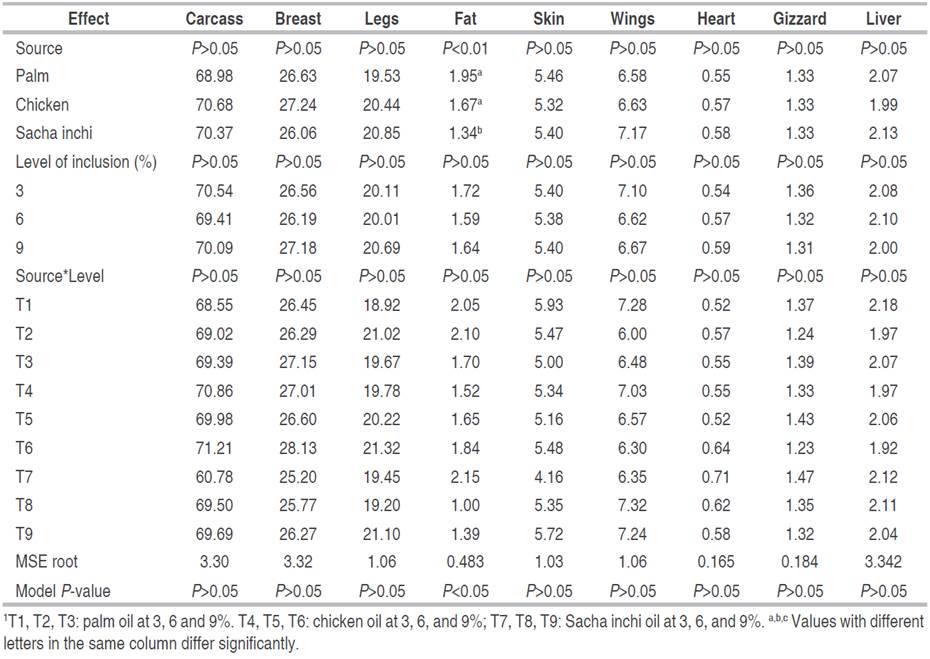
According to the information in Table 5, it is possible to establish that the oil source only affected the weight of abdominal fat, and both, the level of oil inclusion and the interaction between the source and the level of inclusion did not have any influence on the variables analyzed. Regarding the influence of the source, it is clear that Sacha inchi oil (outstanding for being high in polyunsaturated fatty acids) led to lower abdominal fat weights, while for the same variable, there was no difference among the other oil sources, which were characterized by having high contents of monounsaturated (chicken oil) and saturated (palm oil) fatty acids.
When naming some chicken organs and carcass components such as the slaughter weight rate (Table 6), the same trend is evident as in Table 5. That is, the oil source only affected the rate of abdominal fat weight. Both, the level of oil inclusion and the interaction between the source and the inclusion level, had no influence on the variables analyzed, and Sacha inchi oil produced carcasses with the lowest rate of abdominal fat in relation to slaughter weight, having no difference between the other two sources of oil evaluated.
In chicken, the content of abdominal fat is a reliable indicator for judging body fat content. Due to this relationship, it could be expected that the dietary fat effect could be reflected in both abdominal and body fat (Becker et al. 1979). This effect would not only depend on the level of oil inclusion in the diet but also the characteristics and composition of its fatty acids. So, for Crespo and Esteve-Garcia (2002), diets with a higher content of polyunsaturated fatty acids lead to greater absorption of fatty acids and energy than those containing saturated fatty acids; however, it is possible that diets with this type of fatty acids present greater oxidation, which could lead to more endogenous synthesis of these acids from carbohydrates, which would imply a higher energy cost. Therefore, for these authors, if energy retention increases when diets with saturated and polyunsaturated fatty acids are offered, energy consumption should increase independently from fatty acid synthesis.
Although it has been stated that abdominal fat content in chicken depends on both the level of oil inclusion in the diet and the characteristics and composition of its fatty acids, literature records indicate variation in the results generated. It is important to note that most of these studies were conducted with oils other than palm, chicken, and Sacha inchi oils used in this study.
Crespo and Esteve-Garcia (2001) studied four oil sources (tallow, olive oil, sunflower oil, and linseed oil), with two levels of inclusion (6 and 10%), in males from day 21 to 42 of age and females from day 21 to 49 of age. The results of the study showed that abdominal fat and cholesterol content in their legs were lower in birds fed with sunflower and linseed oils. In females, only diets with tallow or olive oil inclusion did increase abdominal fat linked to the level of inclusion. The results of the study suggested that oils with polyunsaturated fatty acids produced less abdominal fat deposition than those with saturated or monounsaturated fatty acids, becoming a similar result as the one previously found with the Sacha inchi study.
Meanwhile, Ferrini et al. (2008), in their study, established that 42-day-old chicks fed with the highest level of polyunsaturated fatty acids diet had lower fat deposition in the skin, both in absolute and relative weight, than those fed with saturated diets. Moreover, the lowest abdominal fat deposition was achieved with the linseed oil diet high in linolenic acid; these authors concluded that chickens fed with polyunsaturated fatty acids compared to those fed with saturated fatty acid diets reduced fat content in their skin and abdomen by 9 and 30%, respectively. Villaverde et al. (2006) stated that birds fed with oils with unsaturated fatty acids such as sunflower and flaxseed decreased body fat deposition compared to those fed with saturated sources such as tallow or olive oil.
According to other studies, an effect of oil type on fat deposition in chicken has not been reported. Griffiths et al. (1977) evaluated the inclusion of 0, 3, 6, and 9% corn oil, highlighted for its polyunsaturated fatty acid content, chicken oil (monounsaturated fatty acids), and their blends in broiler diets. These researchers found no difference in dietary intake, but they found a difference in body weight, being lower for the 9% inclusion. There was a significant effect on feed conversion between 0 and 9%, but not between sources. In line with the present work, these authors reported no significant difference between the levels of inclusion in the oil sources evaluated for abdominal fat weight.
In studies conducted by Pesti et al. (2002), no differences were recorded for variables such as body weight, weight gain, feed intake, or feed conversion factor for 39-day-old broilers fed with diets containing chicken oil and palm oil both at 3 and 6% inclusion. As for abdominal fat, there was no difference associated with the level of the oil source inclusion in the diet; but they observed less abdominal fat deposition in birds with a diet containing chicken oil compared to those that received a diet with soybean oil or the mixture of these two. In this study, Sacha inchi oil produced the least amount of abdominal fat in both absolute and relative values. It can be established that oil sources with a higher level of polyunsaturated fatty acids, such as Sacha inchi oil, produce less abdominal fat compared to saturated sources such as palm oil. Opposite to this result, Scaife et al. (1994) reported no differences in the abdominal fat weight in birds that were fed between days 19 to 52 of age using diets with 5% inclusion of saturated fats such as tallow and unsaturated fats such as soybean oil, rapeseed oil, seafood oil and mixtures of these in a ratio of 50:50 and weight to weight. Duarte et al. (2010) established that bovine tallow, chicken oils, degummed soybean oil, and the mixtures of these oils with tallow and oil, provided in broiler diets, did not influence carcass yield, cuts, and the amount of abdominal fat. These results are in line with those from Crespo and Esteve-Garcia (2002) and Laral et al. (2006).
Firman et al. (2008) reported no difference in performance variables (total or phased consumption of total diet, weight gain, feed conversion), nor in the weight of the hot carcass, leg, wing, breast and abdominal fat among the fat sources evaluated (yellow fat, vegetable oil/animal fat blend, soybean oil, chicken oil, pork fat and beef tallow) provided at the same inclusion level (3%) to Cobb chickens between the day of hatch and seven weeks of age.
Laral et al. (2006) evaluated the effect of soybean degummed oil, poultry viscera oil, acid soybean oil, a mixture of 50% soybean oil and 50% viscera oil, and a mixture of 50% soybean oil and 50% acid soybean oil on the performance, the breast, leg, and carcass composition, and fatty acid profile carcass in broiler chickens. The results were consistent considering that there was no difference between the oils evaluated for carcass and cut performance, crude protein, moisture, and fat content in the carcass and the leg and breast muscles. The situation was different in the fatty acid composition of the tissues analyzed. The carcass of birds fed with viscera oil had a higher rate of monounsaturated fatty acids, and the polyunsaturated fatty acids deposition was affected by the source of oil used in the diet.
CONCLUSIONS
The results of this experiment suggest that there was no consistency in the effects of the evaluated oil source, the level of oil inclusion in the diet, and the interaction between these two sources on the variables of dietary intake, weight gain, and conversion of the diet in the periods established for the evaluation.
In the variables of the carcass and some organs of the birds, the deposition of abdominal fats was the only aspect affected by the source. Sacha inchi oil, noted for being high in polyunsaturated fatty acids, promoted carcasses with a lower rate of abdominal fat in relation to slaughter weight, with no difference between palm and chicken oils.
ETHICAL CONSIDERATIONS
All processes within the experimental analysis were carried out according to the guidelines suggested by "The international guiding principles for biomedical research involving animals" (CIMOS and ICLAS 2012). This project had the endorsement of the committee of ethics in animal experimentation of the National University of Colombia in Medellín CMED-006 as of March 17, 2016.














